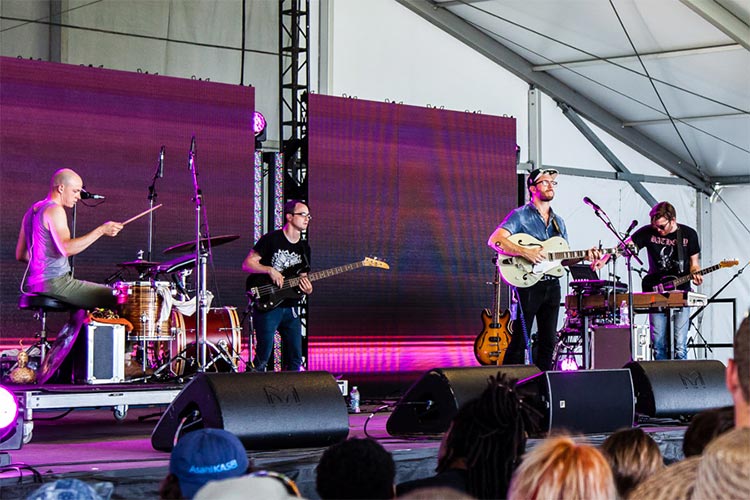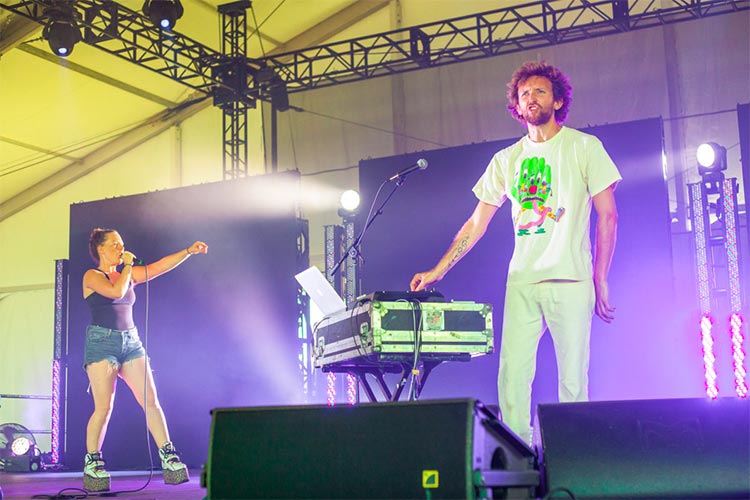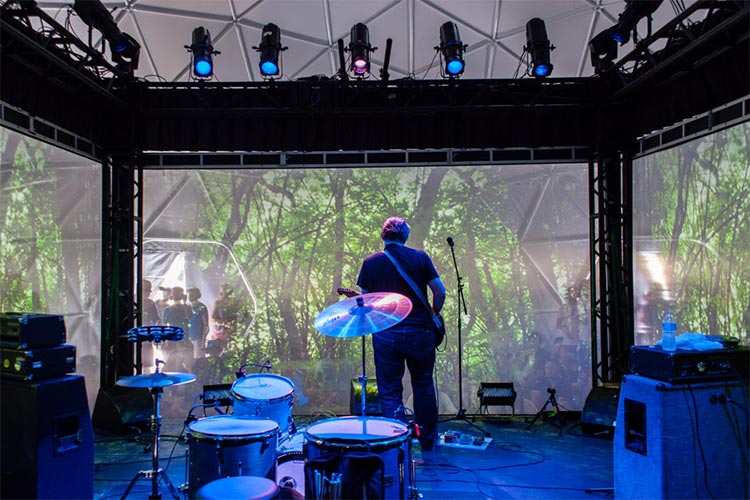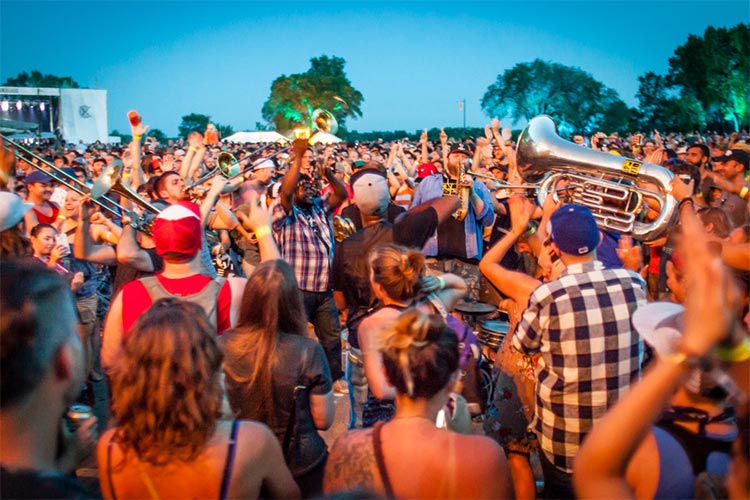The organizers of the inaugural Eaux Claires festival did their homework. The first year of a large-scale event like this is usually a logistical nightmare; who could forget the 12-hour interstate backup welcoming attendees to Bonnaroo 2002? With limited camping space available at Foster Farms, the task of herding tens of thousands of music fans through Eau Claire and onto the grounds had “fiasco” written all over it. Instead, the system of shuttle buses operating from various locations around the city was incomprehensibly efficient. The overall setup of the grounds was ideal; there were no instances of sound cross-bleeding between stages, and aside from a couple instances of lopsided mixes on the main stage, everything sounded crystal clear and balanced. The grounds were packed, making for some long food and beverage lines, but that’s to be expected at any festival. There were no advertising banners, no oppressive security forces, and possibly the most mild-mannered crowd ever assembled. For once, it seemed like the music was the most important thing.
Justin Vernon, co-curator of the fest along with The National’s Aaron Dessner, seems to have handled overnight success the way a hometown fanbase could only dream he might. Rather than milk the folkie sound that made him famous, he’s spent his post-For Emma, Forever Ago career expanding his sonic horizons, collaborating with a host of other Wisconsin-based musicians and seemingly maintaining a solid grasp on humility. Eaux Claires came off as the ultimate celebration of the tight-knit community that initially unleashed Bon Iver upon the world, focusing primarily on Midwestern artists, but branching out into…let’s say as much diversity as one could reasonably hope for at a festival in rural Wisconsin (as in two hip-hop acts, a couple of noise bands, and one bogus black metal band). On paper, it looked like a very mellow weekend, but it didn’t really turn out that way. Vernon himself embodied a refusal to be pigeonholed, and the rest of the field admirably followed suit. We braved the elements and insects and silly stage names, and had an absolute blast.

THE DELLS OF THE ST. CROIX
Our musical odyssey began on Friday afternoon under this large white tent, up a winding, wooded hill path from the main stage area. It was here that we witnessed many of the best sets of the fest. While the main stages stuck mostly with the folkie theme, The Dells was one place where things frequently got weird, although not necessarily with Field Report. (Note: Rather than connect all the dots between Vernon and the various performers at this festival, we’ll trust your Google skills and/or acquired knowledge of the regional music scene.) We’re hopeful that the current lineup sticks for a while, because this was the most intense full-band set we’ve seen Chris Porterfield play in quite some time. The quartet thrived on Porterfield’s more experimental leanings, taking “Wings” into blissfully noisy territory and adding some quirky charm to a retooling of “I Am Not Waiting Anymore.” After two albums full of great songs, it seems like Field Report is closer than ever to finding a distinctive style as a band.

Eaux Claires was pretty light on late-night action; this wasn’t exactly the wastoid, party-til-dawn crowd. Friday night did feature some post-headliner action, though, and hip-hop firebrand Lizzo wound up being one of the most entertaining acts of the weekend. We’d seen her perform opening for Sleater-Kinney at the Riverside in February, and as fun as that set was, it scarcely hinted at the full breadth of Lizzo’s talent. She’s a talented and versatile rapper (we can’t get enough of “Batches & Cookies,” ever), but at least as impressive as a singer. By the end of her too-brief set she had the crowd screaming for more. It was the most purely energetic performance we caught all weekend.
Perhaps the most baffling item of the lineup announcement back in February was the appearance of Japanese experimental noise-mongers Melt-Banana, who are about as far from Midwestern folk as music can get. Still, the duo drew a sizable crowd on Saturday afternoon and quickly had, well, a handful of folks bopping and churning. Vocalist Yasuko Onuki danced wildly around the stage, waving a handheld device that controlled the spastic drum tracks and other electronic elements, while guitarist Ichirou Agata played brutal but often subversively catchy riffs. It was the wildest and heaviest music of the weekend, but somehow it didn’t seem out of place.
However, we did find it difficult to switch gears when PHOX played next on the same stage. In many ways, the Baraboo band embodied the ostensible spirit of the festival as well as anyone, but their performance was relatively low-key, even compared to what we’ve seen from them in the past. Sure, there was the one blisteringly loud guitar solo by a cape-wearing Matt Hollmen halfway through the set, almost as if in mockery of Melt-Banana, but this set was almost too mellow. Still, singer Monica Martin’s charm won us over in the end. “This is a historical day, I truly believe it,” she gushed, and it was tough to argue.
The most exuberant crowd reaction we witnessed all weekend came towards the end of Sylvan Esso’s predictably excellent set Saturday evening. Nick Sanborn was giddy, announcing, “My grandmother’s here. This is her first time seeing us live, so thanks for making me look cool.” Shortly thereafter, the duo played two new, as-yet unreleased songs to deafening cheers and applause. It’s only been a year since the release of Sylvan Esso’s first album, but it seems longer given their omnipresence on local radio and beyond. Even though overplay of the hits may be a factor, these new tunes struck us as more interesting than anything on the debut.

THE DOMES
Behind The Dells sat three white domes, like giant golf balls sunk into the turf. These held various art installations and performances over the course of the festival, with audience members listening through headphones. Of course, summer arrived with a vengeance on Friday; the heat inside the enclosures during sunlight hours wasn’t so much stifling as mentally debilitating. In the largest dome (dubbed “The Banks Of The St. Croix”), Jon Mueller debuted his new project, titled Initiation. Within a translucent cube that filled half the room sat one of those cool-looking but functionally horrible Crosley turntable units. Mueller emerged and announced “Side A,” then put a record on the player to symbolize the performance as being an album. Anyone familiar with Mueller’s Death Blues work might’ve been prepared for what came next, except there was no drumkit—Mueller merely sat behind a console while the “album” played. Over a minimal electronic plod were loops of Muller’s vocals, but more defined and rhythmic than the wall of improvised gibberish of Death Blues. The effect was sometimes meditative, sometimes euphoric, sometimes viscerally tense. Side A featured dance accompaniment by Dawn Springer, whose various phases of movement were impeccably timed with the changes in the music. Side B saw video footage by Chris Hefner projected on the walls of the cube, and more insistent, tribal rhythms. It was every bit as powerful an experience as we’ve come to expect from Mueller—almost as cathartic as emerging from the furnace back into the open air.
Saturday afternoon, we braved the igloo again for Chris Rosenau, who had written all new music specifically for the event. Flanked by serene swamp/forest imagery on the cube walls, Rosenau looped his distinctive blend of blips and plucks, creating cascades of unhindered guitar bliss. He surprised us by bringing Mueller out to drum on his final piece, which swelled to Mogwai-levels of sound, only joyous rather than sinister. It was an echo of that old COCOB’s magic, distilled down to just two of the founders and made fresh again.

By evening, the cruel sun’s powers had diminished, making the temperature inside the dome almost tolerable for Retribution Gospel Choir. We can’t lie: after a terrific Low set on Friday afternoon, we were desperate for another dose of Alan Sparhawk guitar tone. Attendees for this set wore the headphones more as ear protection than anything, as the raw, nasty growl blasted the enclosure straight from Sparhawk’s amp. The more aggressive, jazzy nature of RGC was a far cry from Low]s slow, steady drone, but equally powerful.
PIDDLETRACTOR FAMILY ZONE
In between acts on the two main stages, attendees could find some relief from the sun in the nurturing aura of Grandma Sparrow. Yes, there were often children in attendance, although the “family zone” title may have been a bit misleading, as anyone who has witnessed Grandma Sparrow in action will attest. In 15-minute bursts throughout both days, the twisted fairytales of Joe Westerlund drew plenty of curious folks and devotees, and nothing but smiles all around. Few performers mustered anywhere near the amount of energy and noise that Westerlund and his band cranked out, and as nonsensical as his songs are, he had crowds chanting along at every opportunity, and most likely wired his loopy melodies into lots of brain circuitry over the course of the event.
THE MAIN STAGES
Perhaps partially due to the oppressive heat, we didn’t find ourselves in the sprawling main stage area (“Lake Eaux Lune” and “Flambeaux”) during broad daylight very often, although the vintage country sounds of Sturgill Simpson made the hunt for palatable sustenance more pleasant than it otherwise might’ve been on Friday afternoon. That night’s headliner was The National, who suffered the only truly bad sound mix of the weekend. Singer Matt Berninger’s vocals were way out in front, with the guitars almost completely buried, taking the punch out of several of the songs. The energy skyrocketed when Sufjan Stevens joined the band onstage, though. Ripping versions of “Afraid Of Everyone” and “Squalor Victoria” were highlights of the set. Then, during “Sorrow,” Ragnar Kjartansson (who had been the day’s first performer) cavorted around the stage like a jester, prompting Berninger to chastise him: “Dude, this is a super fucking sad song. Stop it.” Berninger is a far more compelling frontman when he allows himself to break character, and the collaborative, festive atmosphere helped a lot. Vernon naturally made an appearance, helping out on “Slow Show” as well as the encores, but even he couldn’t incite much of a sing-along from the crowd for the “Vanderlyle Crybaby Geeks” closer.
Stevens was back for his own set Saturday night, performing second-to-last. He wasn’t able to put on the spectacular visual production from his Riverside Theater show in April, but the setlist was similar, and Stevens was more relaxed, though equally contemplative. It takes guts to belt out “We’re all gonna die” over and over to a festival crowd, but Stevens had the sea of humanity mesmerized by this point. “Even my happy, strummy songs are about death. Sorry,” he joked prior to “The Dress Looks Nice On You.” But even his most grim ruminations on death come off as more celebratory than depressing. The biggest treat of the set came from Stevens’ 2005 breakthrough album, Illinois. The No BS! Brass Band (who seemed to be everywhere throughout the festival) joined for “Come On! Feel The Illinoise!” and by far the strangest, most electrifying rendition of “Chicago” we’ve ever heard. The National’s Bryce Dessner, who had joined in earlier in the set, also helped close it out with the slow-burning, explosive “Blue Bucket Of Gold,” which cemented this as probably our favorite performance of the weekend.

Prior to Eaux Claires, Bon Iver hadn’t performed in almost three years, and the project is still, as far as we know, officially on hiatus. Despite Vernon’s tireless work with various other projects, the final performance of the weekend certainly suggested that he’s been rehearsing pretty rigorously with his most famous band. He also wasted no time in bringing guests to the stage. British folk trio The Staves had performed the previous day, and their haunting, otherworldly harmonies in opener “Heavenly Father” and especially “Lump Sum” made us regret missing their set. It was “Calgary” that got the crowd truly enraptured, though; there was no doubt that this was what most people had come to see, and we struggled to come up with a festival in recent memory which boasted a single unifying headliner like this.
Had fans dared to hope for new Bon Iver material? Not only were those hopes rewarded, but the two brand new songs turned out to be the climax of the show. The second tune in particular was an ambitious, dare we say progressive piece that built from a ghostly quiet (again featuring The Staves) into an aggressive, grungy electric breakdown, a far cry from anything Vernon has previously attempted. It was glorious, and Vernon seemed to allow himself a moment of triumph amidst his trademark shyness.
As the multitudes sang along to “Skinny Love,” there was no denying the cumulative power of collaborative goodwill from the weekend. Nearly every performer we’d seen had specifically expressed gratitude towards Vernon, the fanbase, the region, and the tangible vibe of this event. Unlike most rock-star platitudes, these stemmed from and bolstered the reality of the situation. This wasn’t just about the music, actually—it was about the community above all. Eaux Claires was the friendliest, most laid-back and genuine atmosphere of any festival we’ve ever been to. After decades of immersion in The Local Scene, this still felt like not only the culmination of something, but the start of something even greater.
